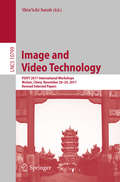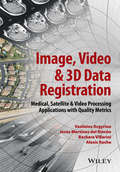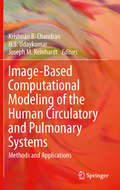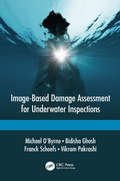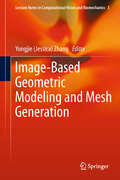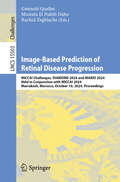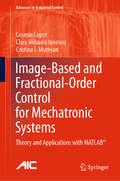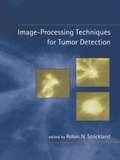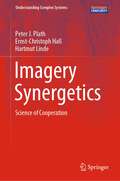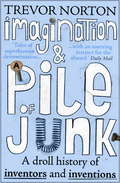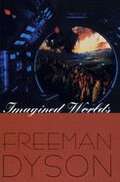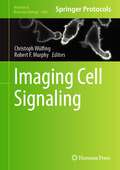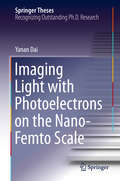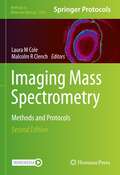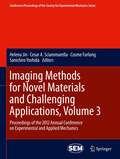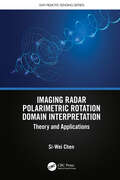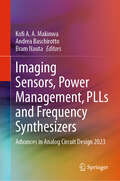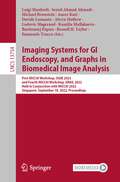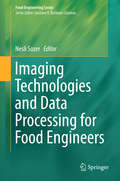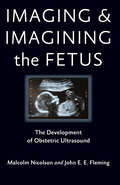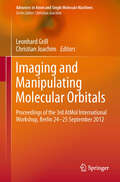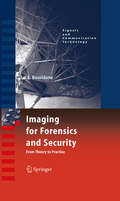- Table View
- List View
Image and Video Technology: PSIVT 2017 International Workshops, Wuhan, China, November 20-24, 2017, Revised Selected Papers (Lecture Notes in Computer Science #10799)
by Shin'Ichi SatohThis book constitutes the thoroughly refereed post-conference proceedings of five international workshops held in the framework of the 8th Pacific-Rim Symposium on Image and Video Technology, PSIVT 2017, in Wuhan, China, in November 2017: Workshop on Human Behavior Analysis; Workshop on Educational Cloud and Image/Video Enriched Cloud Services, ECIVECS; Workshop: Vision Meets Graphics, VG; Workshop on Active Electro-Optical Sensors for Aerial and Space Imaging, EO4AS; and Workshop on Computer Vision and Modern Vehicles, CVMV.The 34 revised full papers and 2 posters presented were carefully selected from 103 submissions. The papers cover the full range of state-of-the-art research in image and video technology with topics ranging from well-established areas to novel current trends.
Image, Video and 3D Data Registration
by Jesus Martinez Del Rincon Barbara Villarini Vasileios Argyriou Alexis RocheData registration refers to a series of techniques for matching or bringing similar objects or datasets together into alignment. These techniques enjoy widespread use in a diverse variety of applications, such as video coding, tracking, object and face detection and recognition, surveillance and satellite imaging, medical image analysis and structure from motion. Registration methods are as numerous as their manifold uses, from pixel level and block or feature based methods to Fourier domain methods. This book is focused on providing algorithms and image and video techniques for registration and quality performance metrics. The authors provide various assessment metrics for measuring registration quality alongside analyses of registration techniques, introducing and explaining both familiar and state-of-the-art registration methodologies used in a variety of targeted applications.Key features: Provides a state-of-the-art review of image and video registration techniques, allowing readers to develop an understanding of how well the techniques perform by using specific quality assessment criteria Addresses a range of applications from familiar image and video processing domains to satellite and medical imaging among others, enabling readers to discover novel methodologies with utility in their own research Discusses quality evaluation metrics for each application domain with an interdisciplinary approach from different research perspectives
Image-Based Computational Modeling of the Human Circulatory and Pulmonary Systems
by Krishnan B. Chandran Joseph M. Reinhardt H. S. UdaykumarImage-Based Computational Modeling of the Human Circulatory and Pulmonary Systems provides an overview of the current modeling methods and applications enhancing interventional treatments and computer-aided surgery. A detailed description of the techniques behind image acquisition, processing and three-dimensional reconstruction are included. Techniques for the computational simulation of solid and fluid mechanics and structure interaction are also discussed, in addition to various cardiovascular and pulmonary applications. Engineers and researchers involved with image processing and computational modeling of human organ systems will find this a valuable reference.
Image-Based Damage Assessment for Underwater Inspections
by Franck Schoefs Michael O’Byrne Bidisha Ghosh Vikram PakrashiInspection is crucial to the management of ageing infrastructure. Visual information on structures is regularly collected but very little work exists on its organised and quantitative analysis, even though image processing can significantly enhance these inspection processes and transfer real financial and safety benefits to the managers, owners and users. Additionally, new opportunities exist in the fast evolving sectors of wind and wave energy to add value to image-based inspection techniques. <P><P>This book is a first for structural engineers and inspectors who wish to harness the full potential of cameras as an inspection tool. It is particularly directed to the inspection of offshore and marine structures and the application of image-based methods in underwater inspections. It outlines a set of best practice guidelines for obtaining imagery, then the fundamentals of image processing are covered along with several image processing techniques which can be used to assess multiple damage forms: crack detection, corrosion detection, and depth analysis of marine growth on offshore structures. The book provides benchmark performance measures for these techniques under various visibility conditions using an image repository which will help inspectors to envisage the effectiveness of the techniques when applied. MATLAB® scripts and access to the underwater image repository are included so readers can run these techniques themselves. <P><P>Practising engineers and managers of infrastructure assets are guided in image processing based inspection. Researchers can use this book as a primer, and it also suits advanced graduate courses in infrastructure management or on applied image processing.
Image-Based Geometric Modeling and Mesh Generation
by Yongjie Jessica ZhangAs a new interdisciplinary research area, "image-based geometric modeling and mesh generation" integrates image processing, geometric modeling and mesh generation with finite element method (FEM) to solve problems in computational biomedicine, materials sciences and engineering. It is well known that FEM is currently well-developed and efficient, but mesh generation for complex geometries (e.g., the human body) still takes about 80% of the total analysis time and is the major obstacle to reduce the total computation time. It is mainly because none of the traditional approaches is sufficient to effectively construct finite element meshes for arbitrarily complicated domains, and generally a great deal of manual interaction is involved in mesh generation. This contributed volume, the first for such an interdisciplinary topic, collects the latest research by experts in this area. These papers cover a broad range of topics, including medical imaging, image alignment and segmentation, image-to-mesh conversion, quality improvement, mesh warping, heterogeneous materials, biomodelcular modeling and simulation, as well as medical and engineering applications. This contributed volume, the first for such an interdisciplinary topic, collects the latest research by experts in this area. These papers cover a broad range of topics, including medical imaging, image alignment and segmentation, image-to-mesh conversion, quality improvement, mesh warping, heterogeneous materials, biomodelcular modeling and simulation, as well as medical and engineering applications. This contributed volume, the first for such an interdisciplinary topic, collects the latest research by experts in this area. These papers cover a broad range of topics, including medical imaging, image alignment and segmentation, image-to-mesh conversion, quality improvement, mesh warping, heterogeneous materials, biomodelcular modeling and simulation, as well as medical and engineering applications. This contributed volume, the first for such an interdisciplinary topic, collects the latest research by experts in this area. These papers cover a broad range of topics, including medical imaging, image alignment and segmentation, image-to-mesh conversion, quality improvement, mesh warping, heterogeneous materials, biomodelcular modeling and simulation, as well as medical and engineering applications.
Image-Based Prediction of Retinal Disease Progression: MICCAI Challenges, DIAMOND 2024 and MARIO 2024, Held in Conjunction with MICCAI 2024, Marrakesh, Morocco, October 10, 2024, Proceedings (Lecture Notes in Computer Science #15503)
by Gwenolé Quellec Mostafa El Habib Daho Rachid ZeghlacheThis book constitutes the proceedings from the MICCAI Challenges, Device-Independent Diabetic Macular Edema Onset Prediction, DIAMOND 2024, and Monitoring Age-Related macular degeneration progression in Optical coherence tomography, MARIO 2024, held in conjunction with the 27th International conference on Medical Image Computing and Computer Assisted Intervention, MICCAI 2024, in Marrakesh, Morocco in October 2024. The 15 papers included in this book from MARIO 2024 were carefully reviewed and selected from 17 submissions, whereas the 6 papers included here from DIAMOND 2024 were carefully reviewed and selected from 8 submissions. These papers focus on a wide range of state-of-the-art deep learning approaches to derive patient specific rules for Diabetic retinopathy (DR) and age-related macular degeneration (AMD) progression prediction from retinal images.
Image-Based and Fractional-Order Control for Mechatronic Systems: Theory and Applications with MATLAB® (Advances in Industrial Control)
by Clara Mihaela Ionescu Cosmin Copot Cristina I. MuresanThis book unites two fast-developing forms of control—vision-based control and fractional-order control—and applies them in mechatronic systems.Image-Based and Fractional-Order Control for Mechatronic Systems is presented in two parts covering the theory and applications of the subject matter. The theoretical material presents the concepts of visual servoing and image-based feature extraction for feedback loops and fractional-order control. It discusses a range of systems from the classic monocular camera to new RGB-D sensors. The applications part of the book first discusses practical issues with the implementation of fractional-order control, comparing them with more traditional integer-order PID systems. The authors then introduce real-life examples such as a manipulator robot and a Stewart platform and results generated from such systems. MATLAB® functions and source codes are included wherever relevant to help readers develop simulations based on the theoretical ideas and practical examples in the text. Suggestions for the use of other pertinent open-source software are also indicated with the places where such may be obtained. With its combination of theoretical ideas and practical examples, Image-Based and Fractional-Order Control for Mechatronic Systems will be of interest to academic researchers looking to develop the fields of vision-based and fractional-order control and to engineers who are looking for developments that will help them provide closer control of their plants than can be achieved with integer-order PID.Advances in Industrial Control reports and encourages the transfer of technology in control engineering. The rapid development of control technology has an impact on all areas of the control discipline. The series offers an opportunity for researchers to present an extended exposition of new work in all aspects of industrial control.
Image-Processing Techniques for Tumor Detection
by David F. Ross"Provides a current review of computer processing algorithms for the identification of lesions, abnormal masses, cancer, and disease in medical images. Presents useful examples from numerous imaging modalities for increased recognition of anomolies in MRI, CT, SPECT and digital/film X-Ray."
Imagery Synergetics: Science of Cooperation (Understanding Complex Systems)
by Peter J. Plath Ernst-Christoph Haß Hartmut LindeThis text will be replaced by the correThis book is aimed to a broad audience of researchers and students who are interested in questions of structure formation in complex systems in nature and society. When we think of synergetics, impressive images of complex structures immediately come to mind. Such images serve us as starting point and guide for understanding structure formation in chemical, biological, physical, geological, and social systems.Many fascinating pictures of new experimental results illustrate the imagery of synergetics and at the same time enable precise statements about the underlying laws based on precise and discussed measurements. In this way, for example, the famous Runge pictures are accessible to a physico-chemical description, and it turns out that the well-known disintegration of the beer foam satisfies a consecutive kinetics with feedback. The modeling by means of cellular automata and iterated function systems enables us to study the cooperative character of pattern formation on sea shells on the one hand but also to show that creativity is a cooperative effect.ct back cover text / information text as soon as we get it.
Imagination and a Pile of Junk: A Droll History of Inventors and Inventions
by Trevor Norton'In his whistle-stop tour of inventions large and small, the scientist Trevor Norton shares the Gershwins' view that invention is fundamentally comic.' The Sunday TimesTrevor Norton, who has been compared to Gerard Durrell and Bill Bryson, weaves an entertaining history with a seductive mix of eureka moments, disasters and dirty tricks. Although inventors were often scientists or engineers, many were not: Samuel Morse (Morse code) was a painter, Lazlow Biro (ballpoint) was a sculptor and hypnotist, and Logie Baird (TV) sold boot polish. The inventor of the automatic telephone switchboard was an undertaker who believed the operator was diverting his calls to rival morticians so he decided to make all telephone operators redundant. Inventors are mavericks indifferent to conventional wisdom so critics were dismissive of even their best ideas: radio had 'no future,' electric light was 'an idiotic idea' and X-rays were 'a hoax.' Even so, the state of New Jersey moved to ban X-ray opera glasses. The head of the General Post Office rejected telephones as unneccesary as there were 'plenty of small boys to run messages.'Inventomania is a magical place where eccentrics are always in season and their stories are usually unbelievable - but rest assured, nothing has been invented.
Imagination and a Pile of Junk: A Droll History of Inventors and Inventions
by Trevor Norton'In his whistle-stop tour of inventions large and small, the scientist Trevor Norton shares the Gershwins' view that invention is fundamentally comic.' The Sunday TimesTrevor Norton, who has been compared to Gerard Durrell and Bill Bryson, weaves an entertaining history with a seductive mix of eureka moments, disasters and dirty tricks. Although inventors were often scientists or engineers, many were not: Samuel Morse (Morse code) was a painter, Lazlow Biro (ballpoint) was a sculptor and hypnotist, and Logie Baird (TV) sold boot polish. The inventor of the automatic telephone switchboard was an undertaker who believed the operator was diverting his calls to rival morticians so he decided to make all telephone operators redundant. Inventors are mavericks indifferent to conventional wisdom so critics were dismissive of even their best ideas: radio had 'no future,' electric light was 'an idiotic idea' and X-rays were 'a hoax.' Even so, the state of New Jersey moved to ban X-ray opera glasses. The head of the General Post Office rejected telephones as unneccesary as there were 'plenty of small boys to run messages.'Inventomania is a magical place where eccentrics are always in season and their stories are usually unbelievable - but rest assured, nothing has been invented.
Imagined Worlds (Jerusalem-Harvard Lectures)
by Freeman DysonImagine a world where whole eons will pass, cultures rise and fall, between a telephone call and its reply. Think of the human race multiplying 500-millionfold or evolving new, unique species. Consider the technology of space colonization, computer-assisted reproduction, the "Martian potato." One hundred years after H. G. Wells visited the future in "The Time Machine," Freeman Dyson marshals his uncommon gifts as a scientist and storyteller to take us once more to such worlds, which may or may not be in our future.
Imaging Cell Signaling (Methods in Molecular Biology #2800)
by Robert F. Murphy Christoph WülfingThis volume explores recent innovations across the entire pipeline of imaging signal transduction, cell preparation, cellular manipulation, image acquisition, and computational analysis. The chapters in this book cover topics such as rapid preparation of living Drosophila pupal macrophages for ex vivo imaging; controlling the potency of T cell activation using an optically tuneable chimeric antigen receptor; in situ imaging of proteins using DNA-PAINT super-resolution microscopy; reconstructing signaling networks using biosensor barcoding; and morphological, spatial, and dynamic models for cellular components. Written in the highly successful Methods in Molecular Biology series format, chapters include introductions to their respective topics, lists of the necessary materials and reagents, step-by-step, readily reproducible laboratory protocols, and tips on troubleshooting and avoiding known pitfalls.Cutting-edge and authoritative, Imaging Cell Signaling is a valuable resource that provides guidance to researchers looking to learn how to effectively tailor design projects to image, manipulate, and model signal transduction.
Imaging Light with Photoelectrons on the Nano-Femto Scale (Springer Theses)
by Yanan DaiThis thesis presents significant advances in the imaging and theory of the ultrafast dynamics of surface plasmon polariton fields. The author details construction of a sub-10 femtosecond and sub-10 nanometer spatiotemporal resolution ultrafast photoemission microscope which is subsequently used for the discovery of topological meron and skyrmion-like plasmonic quasiparticles. In particular, this enabled the creation of movies of the surface plasmon polariton fields evolving on sub-optical wavelength scales at around 0.1 femtosecond per image frame undergoing vortex phase evolution. The key insight that the transverse spin of surface plasmon polaritons undergoes a texturing into meron or skyrmion-like topological quasiparticles (defined by the geometric charge of the preparation) follows. In addition, this thesis develops an analytical theory of these new topological quasiparticles, opening new avenues of research, while the ultrafast microscopy techniques established within will also be broadly applicable to studies of nanoscale optical excitations in electronic materials.
Imaging Mass Spectrometry: Methods and Protocols (Methods in Molecular Biology #2688)
by Laura M Cole Malcolm R ClenchThis second edition details new and updated chapters on key methodologies and breakthroughs in the mass spectrometry imaging (MSI) field. Chapters guide readers through nano-Desorption Electrospray Ionisation (nDESI), Matrix Assisted Laser Desorption Ionisation-2 (MALDI-2), Laser Ablation - Inductively Coupled Plasma-Mass Spectrometry (LA-ICP-MS) ,Imaging Mass Cytometry (IMC) with a variety of diverse samples including eye tissue, crop analysis, 3D cell culture models, and counterfeit goods analysis. Written in the format of the highly successful Methods in Molecular Biology series, each chapter includes an introduction to the topic, lists necessary materials and reagents, includes tips on troubleshooting and known pitfalls, and step-by-step, readily reproducible protocols. Authoritative and cutting-edge, Imaging Mass Spectrometry: Methods and Protocols, Second Edition aims to be a useful and practical guide to new researchers and experts looking to expand their knowledge.
Imaging Methods for Novel Materials and Challenging Applications, Volume 3
by Cosme Furlong Helena Jin Sanichiro Yoshida Cesar SciammarellaImaging Methods for Novel Materials and Challenging Applications, Volume 3: Proceedings of the 2012 Annual Conference on Experimental and Applied Mechanics, the third volume of seven from the Conference, brings together 62 contributions to this important area of research and engineering. The collection presents early findings and case studies on fundamental and applied aspects of Experimental and Applied Mechanics, including papers on: Role of optical interferometry in advancement of material characterizationThree-dimensional imaging and volumetric correlationDigital holography and experimental mechanicsDigital image correlationMetrology and displacement measurement at different scalesOptical methods for dynamic testsOptical methods for and with MEMS and NEMSThermomechanics and infrared imagingImaging methods applied to biomaterials and soft materialsApplied photoelasticityOptical measurement systems using polarized lightHybrid imaging techniquesContouring of surfacesNovel optical techniques
Imaging Radar Polarimetric Rotation Domain Interpretation: Theory and Applications (SAR Remote Sensing)
by Si-Wei ChenPolarimetric rotation domain interpretation is an innovation in radar image processing and understanding. Orientation rotation is a basic operator well known in the classic polarimetry theory, and significant advancement has been made in recent years. This book presents new and advanced concepts, theories, and methodologies in radar polarimetry and bridges the gaps between target scattering diversity, polarimetric radar data, and their practical applications. It provides a comprehensive summarization and investigation of polarimetric rotation domain features and demonstrates novel applications of polarimetric radar target detection, classification, target structure recognition, and urban damage mapping.FEATURES Focuses on basic concepts, key techniques, and various applications of the polarimetric rotation domain interpretation paradigm for the first time in book form Explains, represents, and utilizes the radar target scattering diversity effect Identifies new methods for target polarimetric scattering mechanism understanding Provides a comprehensive investigation of polarimetric roll-invariant features Includes novel application developments for imaging radar target detection, structure recognition, and damage mapping This book is written for researchers and professionals in radar polarimetry, radar imaging, microwave remote sensing, environmental studies, and other related fields. Senior undergraduate and postgraduate students, as well as teachers in the same fields, will benefit from the advancements highlighted in this book.
Imaging Sensors, Power Management, PLLs and Frequency Synthesizers: Advances in Analog Circuit Design 2023
by Bram Nauta Kofi A. A. Makinwa Andrea BaschirottoThis book is based on the 18 tutorials presented during the 31st workshop on Advances in Analog Circuit Design held in Villach, Austria. In it, expert designers share their insights on a variety of topics at the frontier of analog circuit design, with specific contributions focusing on the design of imaging sensors, power management circuits, PLLs and frequency synthesizers. As such, for anyone involved in analog circuit research and development, this book provides a valuable overview of the state-of-the-art.
Imaging Systems for GI Endoscopy, and Graphs in Biomedical Image Analysis: First MICCAI Workshop, ISGIE 2022, and Fourth MICCAI Workshop, GRAIL 2022, Held in Conjunction with MICCAI 2022, Singapore, September 18, 2022, Proceedings (Lecture Notes in Computer Science #13754)
by Emanuele Trucco Bartlomiej Papiez Davide Lomanto Russell H. Taylor Luigi Manfredi Seyed-Ahmad Ahmadi Michael Bronstein Anees Kazi Alwyn Mathew Ludovic Magerand Kamilia MullakaevaThis book constitutes the refereed proceedings of the first MICCAI Workshop, ISGIE 2022, Imaging Systems for GI Endoscopy, and the Fourth MICCAI Workshop, GRAIL 2022, GRaphs in biomedicAL Image and analysis, held in conjunction with MICCAI 2022, Singapore, September 18, 2022.ISGIE 2022 accepted 6 papers from the 8 submissions received.This workshop focuses on novel scientific contributions to vision systems, imaging algorithms as well as the autonomous system for endorobot for GI endoscopy. This includes lesion and lumen detection, as well as 3D reconstruction of the GI tract and hand-eye coordination. GRAIL 2022 accepted 6 papers from the 10 submissions received. The workshop aims to bring together scientists that use and develop graph-based models for the analysis of biomedical images and to encourage the exploration of graph-based models for difficult clinical problems within a variety of biomedical imaging contexts.
Imaging Technologies and Data Processing for Food Engineers
by Nesli SozerFood products are complex in nature which makes their analysis difficult. Different scientific disciplines such as biochemistry, microbiology, and nutrition, together with engineering concepts are involved in their characterization. However, imaging of food materials and data analysis has gained more importance due to innovations in the food industry, as well as the emergence of food nanotechnology. Image analysis protocols and techniques can be used in food structure analysis and process monitoring. Therefore, food structure imaging is crucial for various sections of the food chain starting from the raw material to the end product. This book provides information on imaging techniques such as electron microscopy, laser microscopy, x-ray tomography, raman and infrared imaging, together with data analysis protocols. It addresses the most recent advances in imaging technologies and data analysis of grains, liquid food systems (i. e. emulsions and gels), semi-solid and solid foams (i. e. bakery products, dough, expanded snacks), protein films, fruits and vegetable confectionery and nuts. This book also: Provides in-depth view of raw material characterization and process control Covers structure-functionality and structure-texture relationships Reviews applications to emerging areas of food science with an insight into future trends
Imaging Through Turbulence
by Michael C. Roggemann Byron M. WelshLearn how to overcome resolution limitations caused by atmospheric turbulence in Imaging Through Turbulence. This hands-on book thoroughly discusses the nature of turbulence effects on optical imaging systems, techniques used to overcome these effects, performance analysis methods, and representative examples of performance. Neatly pulling together widely scattered material, it covers Fourier and statistical optics, turbulence effects on imaging systems, simulation of turbulence effects and correction techniques, speckle imaging, adaptive optics, and hybrid imaging. Imaging Through Turbulence is written in tutorial style, logically guiding you through these essential topics. It helps you bring down to earth the complexities of coping with turbulence.
Imaging and Imagining the Fetus: The Development of Obstetric Ultrasound
by Malcolm Nicolson John E. FlemingHow engineers and clinicians developed the ultrasound diagnostic scanner and how its use in obstetrics became controversial.To its proponents, the ultrasound scanner is a safe, reliable, and indispensable aid to diagnosis. Its detractors, on the other hand, argue that its development and use are driven by the technological enthusiasms of doctors and engineers (and the commercial interests of manufacturers) and not by concern to improve the clinical care of women. In some U.S. states, an ultrasound scan is now required by legislation before a woman can obtain an abortion, adding a new dimension to an already controversial practice. Imaging and Imagining the Fetus engages both the development of a modern medical technology and the concerted critique of that technology.Malcolm Nicolson and John Fleming relate the technical and social history of ultrasound imaging—from early experiments in Glasgow in 1956 through wide deployment in the British hospital system by 1975 to its ubiquitous use in maternity clinics throughout the developed world by the end of the twentieth century. Obstetrician Ian Donald and engineer Tom Brown created ultrasound technology in Glasgow, where their prototypes were based on the industrial flaw detector, an instrument readily available to them in the shipbuilding city. As a physician, Donald supported the use of ultrasound for clinical purposes, and as a devout High Anglican he imbued the images with moral significance. He opposed abortion—decisions about which were increasingly guided by the ultrasound technology he pioneered—and he occasionally used ultrasound images to convince pregnant women not to abort the fetuses they could now see.Imaging and Imagining the Fetus explores why earlier innovators failed where Donald and Brown succeeded. It also shows how ultrasound developed into a "black box" technology whose users can fully appreciate the images they produce but do not, and have no need to, understand the technology, any more than do users of computers. These "images of the fetus may be produced by machines," the authors write, "but they live vividly in the human imagination."
Imaging and Manipulating Molecular Orbitals: Proceedings of the 3rd AtMol International Workshop, Berlin 24-25 September 2012
by Christian Joachim Leonard GrillImaging and Manipulating Molecular Orbitals celebrates the 60th anniversary of the first image of a single molecule by E. Müller. This book summarizes the advances in the field from various groups around the world who use a broad range of experimental techniques: scanning probe microscopy (STM and AFM), field emission microscopy, transmission electron microscopy, attosecond tomography and photoemission spectroscopy. The book is aimed at those who are interested in the field of molecular orbital imaging and manipulation. Included in the book are a variety of experimental techniques in combination with theoretical approaches which describe the spatial distribution and energies of the molecular orbitals. The goal is to provide the reader with an up-to-date summary on the latest developments in this field from various points of view.
Imaging for Forensics and Security
by Ahmed BouridaneImaging for Forensics and Security: From Theory to Practice provides a detailed analysis of new imaging and pattern recognition techniques for the understanding and deployment of biometrics and forensic techniques as practical solutions to increase security. It contains a collection of the recent advances in the technology ranging from theory, design, and implementation to performance evaluation of biometric and forensic systems. This book also contains new methods such as the multiscale approach, directional filter bank, and wavelet maxima for the development of practical solutions to biometric problems. The book introduces a new forensic system based on shoeprint imagery with advanced techniques for use in forensics applications. It also presents the concept of protecting the originality of biometric images stored in databases against intentional and unintentional attacks and fraud detection data in order to further increase the security.
Imaging for Plastic Surgery
by Luca Saba Warren M. Rozen Alberto Alonso-Burgos Diego RibuffoPreoperative imaging is increasingly being adopted for preoperative planning in plastic and reconstructive surgery. Accurate preoperative analysis can reduce the length of operations and maximize surgical design and dissection techniques. Imaging for Plastic Surgery covers the techniques, applications, and potentialities of medical imaging technology in plastic and reconstructive surgery. Presenting state-of-the-art research on evolving imaging modalities, this cutting-edge text: Provides a practical introduction to imaging modalities that can be used during preoperative planning Addresses imaging principles of the face, head, neck, breast, trunk, and extremities Identifies the strengths and weaknesses of all available imaging modalities Demonstrates the added value of imaging in different clinical scenarios Comprised of contributions from world-class experts in the field, Imaging for Plastic Surgery is an essential imaging resource for surgeons, radiologists, and patient care professionals.
